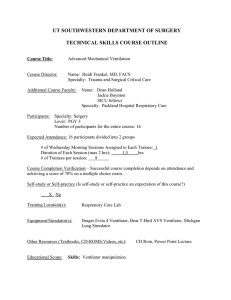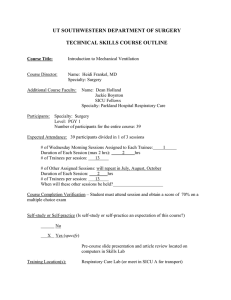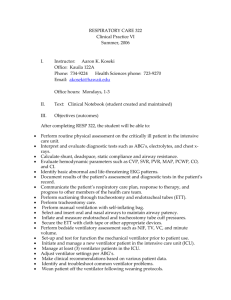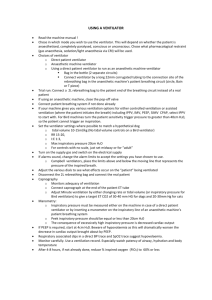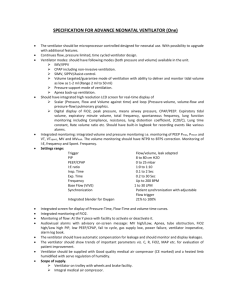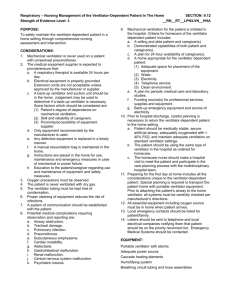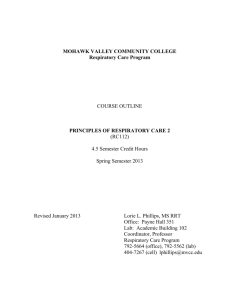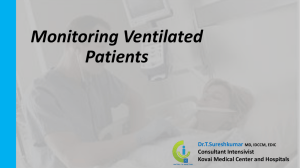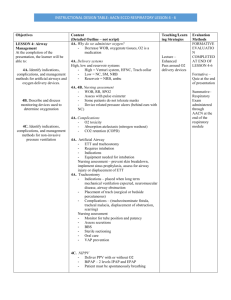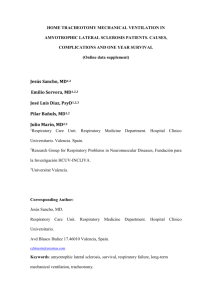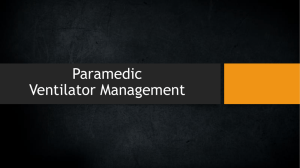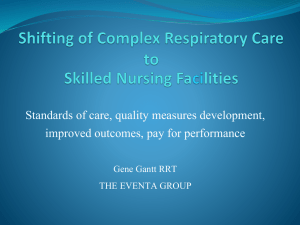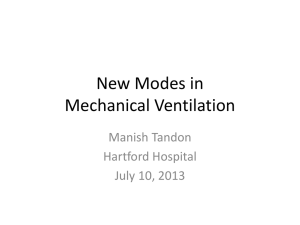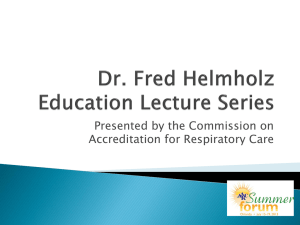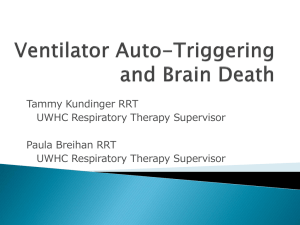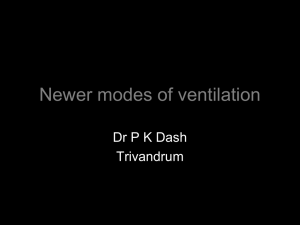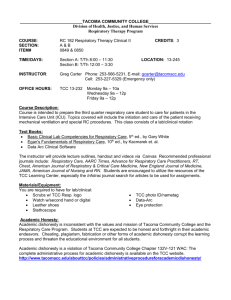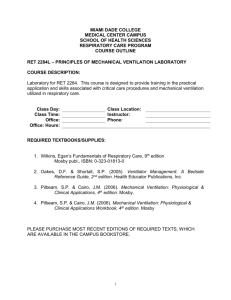PEDIATRIC RESPIRATORY OVERVIEW
advertisement
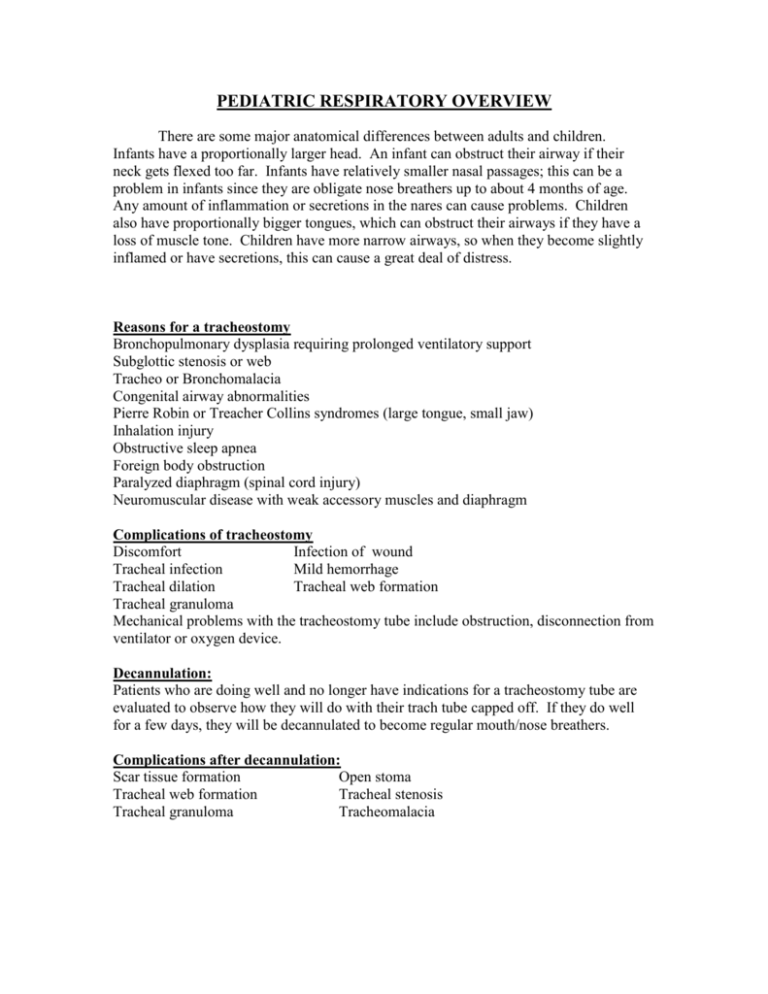
PEDIATRIC RESPIRATORY OVERVIEW There are some major anatomical differences between adults and children. Infants have a proportionally larger head. An infant can obstruct their airway if their neck gets flexed too far. Infants have relatively smaller nasal passages; this can be a problem in infants since they are obligate nose breathers up to about 4 months of age. Any amount of inflammation or secretions in the nares can cause problems. Children also have proportionally bigger tongues, which can obstruct their airways if they have a loss of muscle tone. Children have more narrow airways, so when they become slightly inflamed or have secretions, this can cause a great deal of distress. Reasons for a tracheostomy Bronchopulmonary dysplasia requiring prolonged ventilatory support Subglottic stenosis or web Tracheo or Bronchomalacia Congenital airway abnormalities Pierre Robin or Treacher Collins syndromes (large tongue, small jaw) Inhalation injury Obstructive sleep apnea Foreign body obstruction Paralyzed diaphragm (spinal cord injury) Neuromuscular disease with weak accessory muscles and diaphragm Complications of tracheostomy Discomfort Infection of wound Tracheal infection Mild hemorrhage Tracheal dilation Tracheal web formation Tracheal granuloma Mechanical problems with the tracheostomy tube include obstruction, disconnection from ventilator or oxygen device. Decannulation: Patients who are doing well and no longer have indications for a tracheostomy tube are evaluated to observe how they will do with their trach tube capped off. If they do well for a few days, they will be decannulated to become regular mouth/nose breathers. Complications after decannulation: Scar tissue formation Open stoma Tracheal web formation Tracheal stenosis Tracheal granuloma Tracheomalacia COMMON PEDIATRIC RESPIRATORY PROBLEMS REQUIRING VENTILATION Bronchopulmonary Dysplasia (BPD): BPD is caused by prematurity, exposure to high Oxygen concentration, and mechanical ventilation. BPD develops over a long period of time in stages. It starts out with the formation of a hyaline membrane (HMD). There is usually a Left to Right shunt through a PDA or Patent Foramen Ovale which leads to pulmonary edema. This leads to interstitial fibrosis and emphysematous changes. The best treatment for BPD is to prevent it. BPD can lead to pulmonary hypertension, corpulmonale and even death. Kids with BPD may require Oxygen or mechanical ventilation for many months. They may also have symptoms of airway obstruction. Spinal Cord Injury: The diaphragm is innervated by the phrenic nerve, which originates at C3-C5. If there is injury at that level, the patient may be unable to breathe for himself and at the least will suffer respiratory compromise. These patients often need to have a tracheostomy and chronic mechanical ventilation. Lower injuries often have respiratory compromise as well. The accessory muscles of respiration may be weakened, causing weak cough and the inability to take deep breaths. This can lead to atelectasis, retained secretions, pneumonia and eventually death. Airway clearance techniques are extremely important in these patients. Neuromuscular Diseases: Neuromuscular diseases (NMD) cover a wide variety of diseases including muscular dystrophy, spinal muscle atrophy, amyotrophic lateral sclerosis, Guillain Barre’ syndrome, and myasthenia gravis. Many neuromuscular diseases are incurable and result in a shortened life expectancy. Respiratory failure is the primary cause of death for those with NMD. The conditions in these people that predispose them to life threatening pulmonary complications include: Restrictive lung disease as a result of respiratory muscle weakness and spinal deformity Ineffective cough as a result of muscle weakness and ensuing restrictive lung disease Immobility as a result of muscle weakness or dyscoordination Predisposition to atelectasis as a result of secretion retention and restrictive lung disease Chronic aspiration as a result of dysphagia and exacerbated by an ineffective cough Ventilator Basics Children require prolonged ventilatory support for a variety of reasons which include; lung disease (BPD, hypoplastic lung,), obstructive airway abnormalities (subglottic stenosis, tracheomalacia, bronchomalacia, Pierre Robin syndrome, etc.), neuro muscular disease (muscular dystrophy, Spina Bifida, Arnold Chiari, paralyzed diaphragm), and central hypoventilation. Because of the severity of the disease process, these children are not able to oxygenate and ventilate their bodies adequately. At ACH we generally use three different ventilators. They are the Servo 300 ventilator the LP 10/20, and the LTV. Servo 300 vents are used only in the hospital. They can be used on intensive care patients and patients getting ready to transition to “home” ventilators. The LP vents are “home” vents. When a child is able to tolerate a “home vent”, they are probably close to going home once their family is educated and services are in place. The LTV is another home ventilator that can be used on patients who need PEEP and pressure support. It provides continuous flow to decrease work of breathing. The two main modes of ventilation used in chronic care are SIMV and Pressure Plateau/Pressure control. Synchronous Intermittent Mandatory Ventilation (SIMV) is a mode of ventilatory support using periodic assisted ventilation that allows the patient to breathe in between ventilator breaths. Pressure Plateau/ Pressure control ventilation is a mode used on the LP and LTV “home” ventilators. Children under 10 kg have tidal volumes that are smaller than the minimum volume on the home ventilators. Pressure plateau/ Pressure control use a volume and then pressure limits the amount of that volume so that the patient gets an appropriate tidal volume. Ventilator Alarms High Pressure: The high pressure alarms if the patient coughs, or there is a kink or obstruction in the circuit (sometimes water in the tubing). When your patient has a highpressure alarm, suction the patient if necessary and check to be sure that the circuit does not have water in it or a kink. If these actions do not solve the problem, bag the patient and call a respiratory therapist. Low Pressure: The low-pressure alarm will sound if there is a leak. The patient or circuit may be disconnected or there may be a large leak around the patient’s tracheostomy tube. Check the connections starting at the patient. If you are unable to quickly find the source of the leak, take the patient off the ventilator, bag and call a respiratory therapist. WEANING/ SPRINTING: When a patient becomes stable in regard to their pulmonary status, they may begin weaning from the ventilator. This is usually done for 10 minutes the first time to see if the patient can tolerate being off the ventilator. The “sprints” gradually increase in length and frequency as long as the patient tolerates doing their own work of breathing. Some patients are able to be off the vent all day and eventually may wean off ventilatory support altogether. Some people, because of their disease process may never be able to wean off of the ventilator. SPEAKING VALVES: When patients are alert and demonstrate potential benefit in communication, respiratory, or swallowing function, they should be evaluated for a speaking valve. Patients must be awake and responsive, medically stable and have the ability to exhale around the tracheostomy tube (or tolerate cuff deflation), and must be able to manage their secretions at a basic level. Before placing a speaking valve, some baseline information should be obtained: pulse ox, heart rate, blood pressure, respiratory rate, skin color and patient responsiveness. These should all be monitored during the first trials of a speaking valve. If a patient exhibits signs/ symptoms of respiratory distress, they should be placed back on the ventilator and possibly tried on the valve later when the distress has resolved. Patients who use a speaking valve for extended periods of time may need extra humidification. This can be provided with a heated, humidified trach collar or by instilling a few drops of normal saline lavage to their trach a few times an hour. When using a speaking valve inline with a ventilator for the first time, you will need to have someone present to make any necessary adjustments to the ventilator (the PEEP and/or rate may need to be adjusted).

